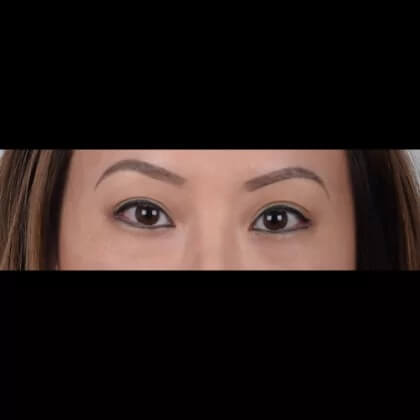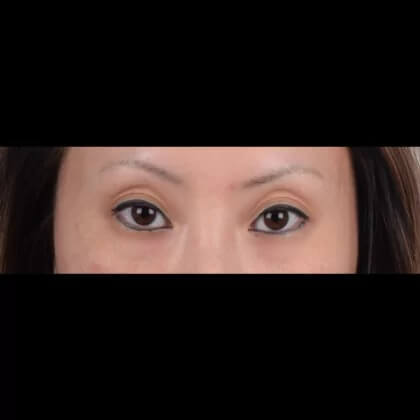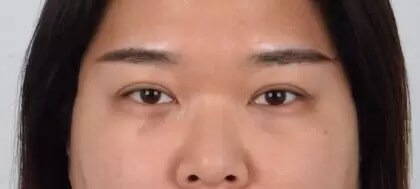The curvature shape of the eyelid is crucial in altering the character of a person’s face, such as enhancing a sense of alertness or youth. The harmonizing depth of the crease is also important, since a shallow crease can appear too soft and unnoticeable while deeper depth appears harsh and unnatural. The fullness of the crease is a measure of how distended the skin appears within the crease. Attaining balance of the fullness is also crucial in creating a natural crease and bigger eyes.
These three factors have dramatic effects on the appearance of a patient, as any distortion in one of the factors can result in an unnatural eye appearance. 3D ST™ allows the surgeon to have control over all three factors, and it can also be used for revision procedures to achieve all three factors.
3 Dimensional Suture Technique Double Eyelids Surgery
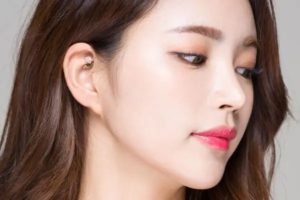 The 3D ST procedure involves Dream Medical Group’s most advanced non-incisional technique for creating a flawless double eyelid crease. The 3D ST procedure involves a novel suture technique that is part of the so-called “new generation” of suture techniques for its use of dynamic, biomechanically controlled technology. Prior to the improvements, the traditional suture method was often criticized for a couple reasons; it was often limited to patients with eyelids with thin skin or adequate strength in the eye elevating muscle, and sutures were frequently prone to loosening in the eyelid skin.
The 3D ST procedure involves Dream Medical Group’s most advanced non-incisional technique for creating a flawless double eyelid crease. The 3D ST procedure involves a novel suture technique that is part of the so-called “new generation” of suture techniques for its use of dynamic, biomechanically controlled technology. Prior to the improvements, the traditional suture method was often criticized for a couple reasons; it was often limited to patients with eyelids with thin skin or adequate strength in the eye elevating muscle, and sutures were frequently prone to loosening in the eyelid skin.
Furthermore, the traditional method implemented very static, two-dimensional methods which only gave control of where to place the crease. Obviously, every eye is unique in that it has its ideal type of crease – the height of the crease alone cannot achieve the best eye shape for a patient. In this sense, the new technique gives control over several other important factors that achieve a higher balance between one’s eyes and overall face shape.
About 3D ST
The 3D ST procedure was devised and perfected after years of intense research conducted by Dr. Kim (Dream Medical Group’s Director of Technology and Scientific Advancement) and Seoul National University graduates of Dream Medical Group. Together, they analyzed the underlying eyelid tissue, and determined the maximum stress tolerable for each individual tissue. This method, coined VPM3 for Vector Per Millimeter3 as a scientific measuring unit for force per volume, contributed greatly to the 3D ST procedure. The 3D ST procedure is truly state-of-the-art, as it involves an unprecedented engineering application and sound scientific analysis. Furthermore, it uses minimally invasive operations to avoid visible scarring, per tradition of Dr. Kim and other members of Dream Medical Group.
It has become a very popular procedure in the Korean media, and has also been performed on many Korean celebrities. The 3D ST procedure has become proprietary to Dr. Kim and Dream Medical Group.
Dynamic, Natural Results
The 3D ST procedure is renowned in South Korea for its dynamic results that mimic the natural double eyelid crease. The muscle tightening combined with a complementary crease results in refined eyes that exude alertness, femininity, and unique character. Figures 1 and 2 represent a patient who received a 3D ST procedure from Dr. Kim. Prior to the operation, this patient had weak eyelid muscles that could not bear the load formed by a traditionally made crease. If she had undergone a traditional suture technique, her eyelids would have drooped due to the physical burden, putting her eyes off proportion and aesthetic balance.
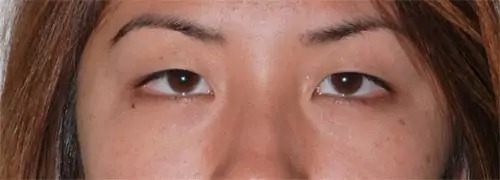
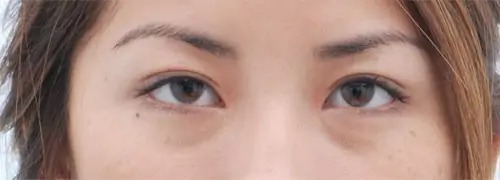
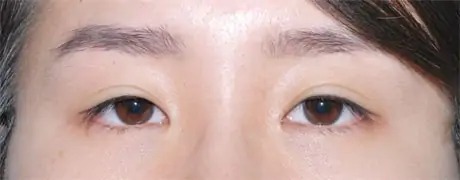
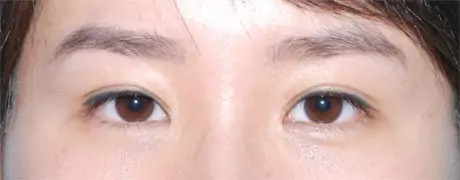
Figure 4. After operation, frontal view. The 3D ST procedure was performed to tighten the patient’s eye-elevating muscles, and place new sutures. The eyes appear much more alert and feminine. The outer eyelid is no longer excessively depressed, and the crease is much more balanced in its depth and fullness.
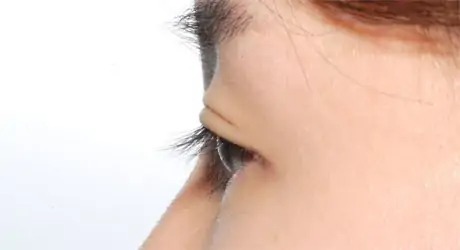
Figure 5. Before operation, side view. The upper eyelashes droop downward due to the excessive load placed on the eye-elevating muscles. The eyes appear downcast and only partially open, yielding a tired, dull character to the patient. The crease is visibly thick and full, and the skin protrudes outward.
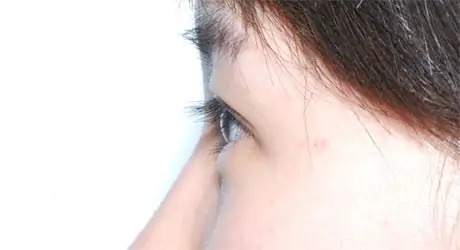
Figure 6. After operation, side view. The upper eyelashes no longer droop, and the eyelid skin is much more uplifted. There is no visible burden of excess load that used to protrude outward. The crease is much more defined, and yields a sharper, more alert demeanor to the patient.
These results demonstrate the power of the 3D ST procedure – its ability to lift the eyelid by muscle tightening rather than simple suture fixation, and create the ideal eye shape and size. The double eyelid crease possesses a recoiling effect as the eye opens and closes, appearing realistic and dynamic. Its speed of formation increases as the eye opens, which emulates the movement of a natural crease. Although subtle, this dynamic movement of the crease is significant – it is the main distinction between just a crease, and a crease that is complemented with the correct eyelid shape and muscle function.
Techniques
3D ST™ is the latest, most innovative suture technique for double eyelid surgery that mimics the natural Asian eyelid fold in anatomy and functionality. 3D ST™ is performed exclusively by Dr. Kenneth Kim, innovator and patent holder of the 3D ST™.
While surgeons could use previous suture techniques to control the height of the crease, height itself does not always provide the most natural and dynamic result that a patient desires. In addition, surgeons must consider the strength of the eye elevating muscle before performing the suture technique to determine whether a patient’s muscle is powerful enough to hold an extra fold. Otherwise, a weak eye elevating muscle cannot bear the weight of the extra fold, causing a shallow or loosening fold. Although patients may desire a suture technique for fast recovery and a natural looking crease, previous suture techniques are not advised for patients with ptosis. Unlike previous suture techniques, the 3D ST™ is innovative in that this technique can be performed for patients with mild ptosis. This technique is ideal for patients with the following indications:
- Patients who have had prior double eyelid surgery and require a less invasive procedure to prevent additional scar tissue
- Patients with mild to moderate ptosis
- Patients with regional weakness in the eye muscles (i.e., eyelids that dip down either toward the nasal or the outer side of face)
Traditionally, surgeons performed ptosis correction procedures by opening eyelids anteriorly by making an incision directly on the eyelid, which allowed surgeons to only perform an incisional method for creating the double eyelid crease. Even though patients may have had ideal thickness and eyelid tissue composition for suture technique, they may have had ptosis that forced them to choose the incisional technique. The recent advent of the 3D ST™ allows the surgeon to create double eyelid crease with suture method while also correcting ptosis (Refer to Ptosis Correction Surgery).
Medical Publications
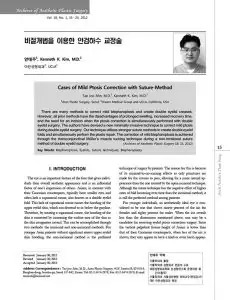
Archives of Aesthetic Plastic Surgery, Vol. 18, No. 1
2012
This article introduces the minimally invasive double eyelid surgical technique, in which a permanent suture is used in order to make the double eyelid crease and correct mild ptosis without making an incision. The advantages are minimal to no scarring, quick recovery time, and minimal trauma to the eyelid tissue. Lastly, the advantage of the present method is its technical simplicity and relatively short operating time.




